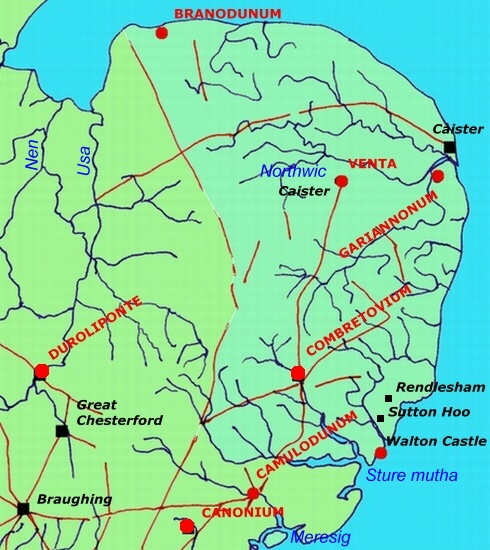The area between the Wash and Essex which included the Saxon Shore forts at Brancaster, Burgh Castle and Walton Castle became the land of the East Angles.
 Any Saxon settlements that may have been made under Roman auspices were absorbed and little or no trace of Roman organisation remains. Cremation burials typical of the pagan Angles predominate. Although the earliest settlements seem to have been in Norfolk, the East Angles built their royal site at Rendlesham on the river Deben not far from the eroded site of Walton Castle. It is assumed that the sixteen burial mounds overlooking the river here are those of the royal family. Both Henry VIII and Elisabeth I dug the mounds for treasure. The majority of these graves remain unexcavated.
Any Saxon settlements that may have been made under Roman auspices were absorbed and little or no trace of Roman organisation remains. Cremation burials typical of the pagan Angles predominate. Although the earliest settlements seem to have been in Norfolk, the East Angles built their royal site at Rendlesham on the river Deben not far from the eroded site of Walton Castle. It is assumed that the sixteen burial mounds overlooking the river here are those of the royal family. Both Henry VIII and Elisabeth I dug the mounds for treasure. The majority of these graves remain unexcavated.
In 1939 one of them yielded up the world famous Sutton Hoo ship burial. Objects buried at  and the nature of the burial itself are said to show strong affinities to Sweden. The earliest possible date for the burial is established by the presence of Merogivinian coins and lies between 620 and 640. Although it is not known who was buried in this fine ship (there is no certainty that a body was present), there are several royal candidates who died at the appropriate time.
and the nature of the burial itself are said to show strong affinities to Sweden. The earliest possible date for the burial is established by the presence of Merogivinian coins and lies between 620 and 640. Although it is not known who was buried in this fine ship (there is no certainty that a body was present), there are several royal candidates who died at the appropriate time.
Like the Denningas to the south, the Saxon Shore fort at Walmer Castle could have been the focus of early settlement by the Wuffingas, the East Saxon royal family. Rendelesham some six kilometers further up the river than Sutton Hoo is where Bishop Cedd baptised Swithelm king of the East Angles and there can be no doubt that here or nearby, was the seat of the royal family. Nevertheless, no trace has yet been found of the early church that we are told was built here, or of a royal hall of the type excavated at Yeavering Bell in Northumberland.
Protected by the belt of the fenlands to the east and by a forest belt to the south, the kingdom of the East Angles managed to retain its independace until destroyed by the Danes in the ninth century.